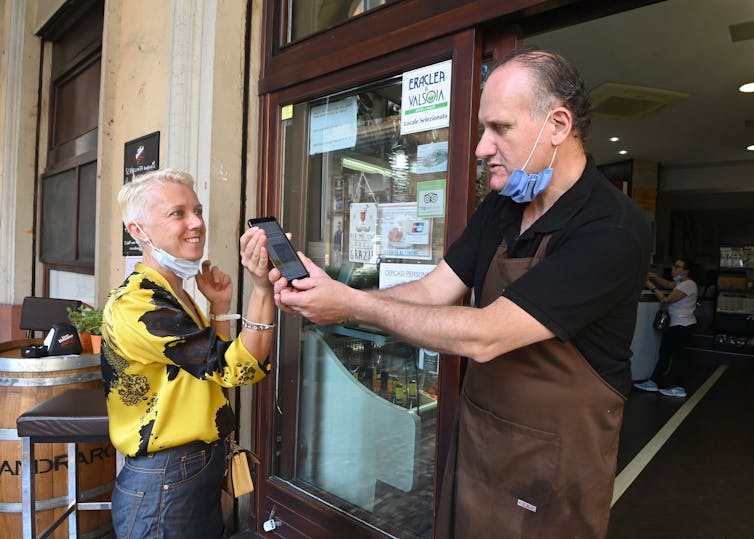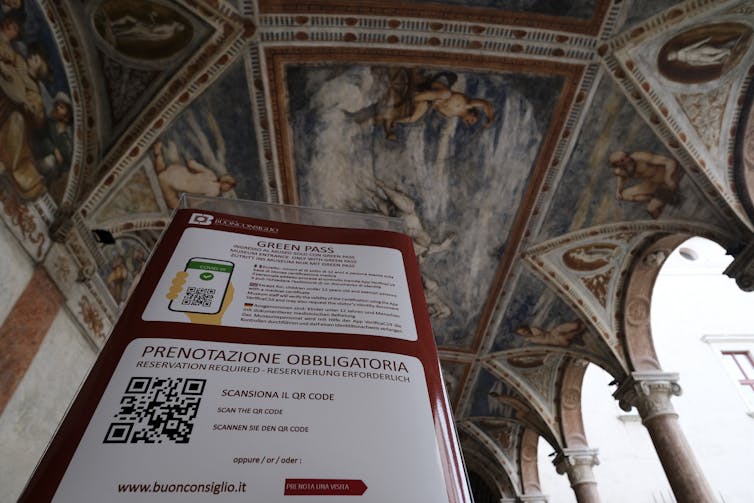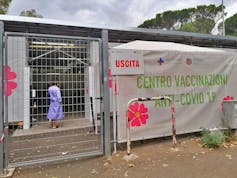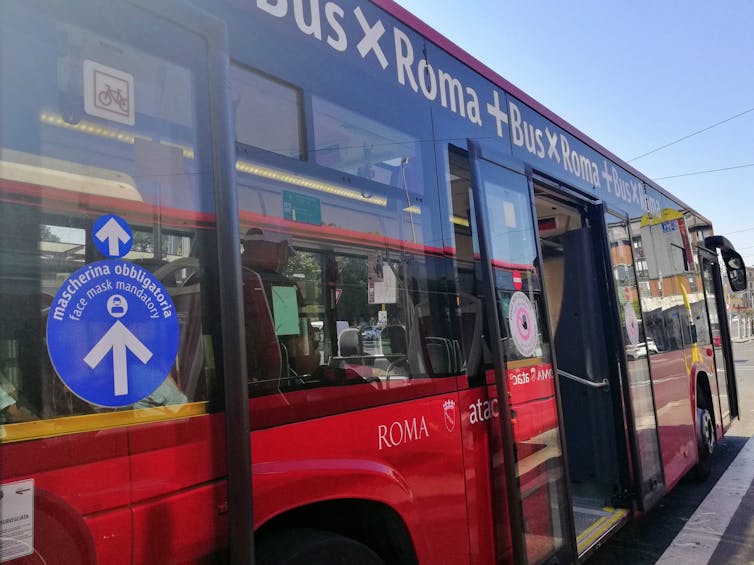Italy – once overwhelmed by COVID-19 – turns to a health pass and stricter measures to contain virus

Italians must now present a form of vaccine passport called a ‘Green Pass’ to enter many indoor establishments. Xinhua News Agency via Getty Images
Courtesy of Sara Belligoni, University of Central Florida
Cases of COVID-19 are surging around the world, but the course of the pandemic varies widely from country to country. To provide you with a global view as we approach a year and a half since the official declaration of the pandemic, editors from The Conversation around the world commissioned articles looking at specific countries and where they are now in combating the pandemic.
Here, Sara Belligoni, a public policy scholar now visiting Rome who wrote for us about the devastating wave of cases in Italy in early 2020, reports on the country’s increasingly stringent rules to encourage vaccination and bring daily life closer to prepandemic times. You can see the whole series of articles on TheConversation.com.
Italy was the first Western democratic country that faced the COVID-19 crisis. In early 2020, as parts of the country were being overwhelmed with coronavirus cases, some media outlets argued that the Italian government had taken too long to impose restrictive measures to fight the spread of the coronavirus.
But Italy has learned several lessons since its first national lockdown on March 9, 2020, and now – a year and a half after that first crushing wave of COVID-19 cases – the country has put in place measures that in some cases are more stringent than in other countries, including the United States.
With these new protocols in place – notably, a health certificate to show vaccination status for certain activities – daily life is moving toward what many people call a new normal. Despite some opposition, Italians support these measures, even when they come with a degree of discomfort or extra steps.
A vaccine passport
As of Aug. 6, 2021, the government requires individuals to present the “Green Pass” – Italy’s extension of the European Union Digital COVID Certificate – to attend large events, dine indoors, access gyms and more. The Green Pass is essentially a “vaccine passport”: a document, either digital or printed, that confirms its holder has tested negative for the virus in the last 48 hours, been fully vaccinated or recovered from a case of COVID-19.
The Italian government’s ‘Green Pass’ proof of vaccination mandate includes popular destinations like museums. Alessio Coser/Getty Images
According to a survey conducted by SWG Research, more than 50% of Italians supports the Green Pass to regulate activities other than traveling. Business owners welcomed the Green Pass as a tool to avoid more restrictive measures – if not even another lockdown in the fall.
With the more contagious delta variant of the coronavirus spreading rapidly, the Italian government is urging more people to get vaccinated, and requiring use of the Green Pass seems to be motivating more people to get the shots. As soon as Prime Minister Mario Draghi announced the Green Pass requirements on July 22, 2021, several regions registered record bookings for vaccine appointments, including Abbruzzo, Lazio, Lombardia, Piemonte and Toscana.
Progress in the vaccination rollout
Based on what is reported in the media, the general public considers the Pfizer-BioNTech and Moderna vaccines the most effective against the delta variant of the four vaccines approved by the European Medicines Agency. So in the recent surge of vaccination appointments, most people registered to receive the Pfizer or Moderna shots, as in the case of the Marche region.
As of Aug. 4, 2021, Italy’s national vaccination rates were higher than those of the United States, with 53% of eligible people fully vaccinated, compared to 50% in the U.S., and 64% having received first shots, versus 58% in the U.S.
Vaccination site, administering the Pfizer vaccine by appointment, in Rome during July 2021. Sara Belligoni, CC BY
Italian COVID-19 Emergency Commissioner, General Francesco Paolo Figliuolo, has set a goal of 80% of eligible persons vaccinated by the end of September. According to Giovanni Rezza, the Health Ministry’s Director of Prevention, that would allow the country to get back to “pseudo-normality” within the first months of 2022.
Color system tracks the pandemic across regions
With low percentages of both intensive care and non-critical hospital beds occupied by COVID-19 patients – 3% and 4% respectively as of Aug. 4, 2021 – as well as widely available vaccines, the Italian Ministry of Health has revised how it uses its color system to set regional public health mandates based on an area’s pandemic situation.
For over a year, colors were assigned – white, yellow, orange or red, in order of emergency level – based on the region’s number of COVID-19 cases. But as of the Prime Minister’s executive order of July 22, the colors are now assigned weekly based on both infection rates and hospitalization rates per 100,000 residents.
A region moves into the red zone when the weekly infection rate rises above 150 per 100,000, combined with an intensive care occupancy rate of 30% and an overall hospitalization rate of 40%.
Regional governors strongly support these latest changes in the color system because they account for not only the total number of infections and hospitalizations, but also the overall severity of the pandemic in the region.
Masks mandates
In addition to the Green Pass, several requirements remain in place, such as mask wearing and social distancing when indoors, and social distancing even when outdoors. When it is not possible to maintain social distancing outdoors, then masks must be worn.
The only exceptions to the mask mandate are for children under the age of 6, as well as for people with disabilities and their caregivers when wearing a mask would prevent communication or care.
Italy’s seaside destinations, popular with both Italians and tourists, are open this summer – with beach resorts, restaurants and bars observing social distancing and mask mandates as needed or required by the government.
Indoor dining is resuming in Italy, particularly given the reopening of the country to tourists. But during my recent visit, I’ve observed that many people still prefer to eat outdoors – which is actually the typical choice of Italians during the summer, pandemic or no pandemic.
Outdoor mask mandates are now limited to situations where social distancing is not possible, such as during sport events or in line when entering museums. I’ve noticed, however, that many people are choosing to wear masks on the streets as well as indoors, even when not mandated.
The tourism industry has eagerly welcomed the government’s reopening of the country to foreign visitors. Travelers entering Italy from some countries, including the United States, are now required to show an official proof of vaccination – such as the EU Digital Certificate or a U.S. Centers for Disease Control and Prevention vaccination card – a negative COVID-19 test or a certificate of recovery from COVID-19 signed by a health care provider.
Adjusting work life and school
Offices are still offering employees the option to work remotely, especially at-risk employees. Where employees who are not in an at-risk category are going back to work, they usually have alternate shifts so fewer people are in the office at the same time.
Public transportation signs in Rome during July 2021 require people to board the bus from the back door and get off from the middle one – the door closest to the driver is blocked to protect their health and well-being. Sara Bellogini, CC BY
Several companies, including international firms with offices in Italy, are taking steps to ensure compliance with the latest pandemic laws. For example, Ferrari, which closed its main factory in Maranello three days before the first national lockdown was imposed, has established a small internal task force to ensure the company follows the government’s rules and recommendations.
The school year officially starts on Sept. 13, 2021, but the government has not yet issued official policies for school reopenings, and it remains unclear what measures will be in place during the school year. Factors that could affect this include the pace of vaccination among children and youth aged 12 to 19 years, and how well schools will be able to maintain social distancing – 6 feet between students and teachers, and 3 feet between students – as some schools may not have enough space in their classrooms.
But the system of showing proof of vaccination is being implemented in education as well: Starting in September, teachers, school staff and students at universities will need to show a Green Pass or get tested regularly.
[Understand new developments in science, health and technology, each week. Subscribe to The Conversation’s science newsletter.]![]()
Sara Belligoni, Ph.D. Candidate in Security Studies, University of Central Florida
This article is republished from The Conversation under a Creative Commons license. Read the original article.






